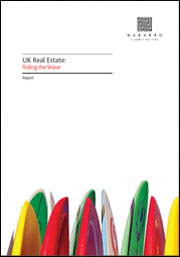30th July 2015
Five key insights from the UK’s top property investors
 The national law firm Nabarro have just published their latest UK Real Estate research which interviewed 271 property investment professionals who together are responsible for portfolios worth more than £400bn.
The national law firm Nabarro have just published their latest UK Real Estate research which interviewed 271 property investment professionals who together are responsible for portfolios worth more than £400bn.
The research shares the insights and predictions of these investment experts and paints a buoyant picture for the real estate market in the years to come. In fact, the report itself is called “Riding the Wave” and suggests we are at the crest of the current cycle.
I’ve read through the report and share some of the most interesting things to emerge from it.
1. Property investors can be optimistic
The research found that more than three-quarters of those polled (77%) are more optimistic about the real estate market compared to last year and just 3% are more pessimistic. The combination of low interest rates and current property investment yields are a heady mix for investors compared to rival investments like Government bonds.
Equally, fears about an imminent downturn in the market have greatly reduced. Last year, almost a fifth of those polled feared a downturn within the next two years. In this poll, just 3% are worried about the same.
However, when you look at the five-year predictions, 42% of those polled say the chances of a downturn are high. This isn’t surprising as the research demonstrates many believe we are half-way through the current cycle and a major correction at some point will be inevitable.
With interest rates set to rise steadily at some point soon, but still remain at a historically low level, we will undoubtedly see a further correction in the property market, but this could well be felt by way of another stagnant period as a number of factors take hold.
These factors include the impact of a rate rise on those who continue to be burdened with high levels of debt. This could provide opportunities, however, business confidence is strong and any gradual increase in rates could be circumnavigated by improving occupier levels and an increase in rental growth.
The occupier market may improve investment stock availability as developers gain confidence, but this will take time and, at present, there seems sufficient investment demand to outstrip supply for a number of years.
The market is therefore likely to remain stable and supported by a growing occupier market and investor appetite. Adjoining these two factors is the global desire to invest in UK real estate which is seen as a “safe haven” while some European and Asian markets remain unstable.
Too much demand, not enough supply and a slow production line = slow and stagnant, but a stable service
2. Alternative investments are growing in popularity
Unsurprisingly, offices still remain the number one asset choice for investors but there has been a major shift in the popularity of alternative investments. The big mover has been residential property which is now the second most desirable asset for investors.
Rougemont has recently invested in a residential opportunity in Helmsley, North Yorkshire where much of the appeal is being fueled by the growing lack of supply of houses and a unique location. Most agree that the UK needs to build around 200,000 new homes a year to meet demand and we’re not even delivering half of that.
While industrial and retail remain attractive, other big movers include distribution and logistics due to the rise in e-commerce and other alternative investments like healthcare and student housing.
3. A British exit from the EU is the greatest threat to UK real estate

The Conservative’s securing a majority at the last General Election has been widely welcomed across the investment sector, but the prospect of Britain leaving the EU following a promised referendum is seen as a major threat to the stability of the market.
Two-thirds of those polled said an EU exit would be bad, saying it would cause significant disruption in the short-term and would send a poor signal to international occupiers in the longer-term. Crucially, many are sceptical that Britain will leave the EU and few are delaying investment decisions as a result.
In reality, the impact of an exit from the EU is extremely difficult to predict but my feeling is that this referendum will be used as a tool for Prime Minister David Cameron to renegotiate a better deal for Britain and that property will largely remain unaffected.
Another key concern was a rise in interest rates as many property companies and developers are still heavily in debt. Surprisingly, few were concerned about a Greek exit from the EU, with just 1% saying it could destabilise the UK market.
4. Devolved powers to the north will be key
The proposed Northern Powerhouse initiative – a plan to give more powers to Northern England to speed up infrastructure and development work – has been warmly welcomed across the real estate sector.
The north is seen as a land of opportunity for developers, investors and occupiers alike and I’ve written at length about the growing popularity of the regions in our blogs. As a result, a resounding 84% of those in the poll supported the Northern Powerhouse plans.
By strengthening links across the Pennines and from Liverpool up to Newcastle, developers believe the north can demonstrate real strength and vision and that will only help to improve investment prospects.
5. Manchester is the most attractive investment destination
With increasing commitments like HS2, the Northern Rail Hub and the Northern Powerhouse, Manchester has topped the list for the most appealing investment prospect. Climbing in popularity again, Manchester was named by 79% of those in the poll and was closely followed by Birmingham, Bristol and Leeds.
What’s also interesting is the fall in popularity of Scottish cities. The recent referendum and the rise of the SNP has shaken investor confidence, with many worried about land reform proposals and changes to the political and legal framework.
The top six “cities or towns to watch” were Cambridge, Reading, Liverpool, Newcastle, Oxford and Sheffield. Each of these has the “golden triangle” of ingredients – solid commuter connections, a strong and growing economy and excellent quality of life – and it’s what investors looking to the regions should be looking for.
